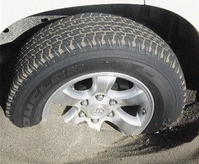
Test driving might seem glamorous, but it often isn't. It involves a lot of seat time, setting up benchmarks and, sometimes, dealing with hairy situations. One of the most time-consuming things in this job is freeing a vehicle stuck in the sand. It has happened so often now that Automotives has decided to share some hard-learnt secrets.
1. Do not think that your four-wheel drive Corolla was meant for beachcombing. It wasn't. Four-wheel drive on these vehicles is used more for handling or glare ice conditions. Know your vehicle and its limitations.
2. Maintaining momentum is the key to sand driving. Think of your car as a boat. When your boat is moving forward it rises out of the water. Your car is the same. The opposite happens when you let off the gas. It sinks. Not good!
3. Wheel spin is not good - if your car is throwing up rooster tails of sand, back off the gas a little. Rooster tails means that the vehicle is also piling sand in front of the tyres. Smoothness is the key here; full-throttle starts on sand is a sure way to dig yourself in.
4. If your vehicle starts to dig in, quick flicks of the wheel - 90 degrees around centre, left and right - this allows the sidewall of the tyre to form part of the contact patch and might get you back on plane.
5. If the steering flicks don't work, and you feel the vehicle actually bogging, stop. Engage reverse, and try to drive out the way you came in. If you get traction, try and change direction so the vehicle comes out of the hole it just dug. Too much lock is also a no-no. Your front wheels act more like a rudder in sand, and provide impedance to forward movement if turned to full lock, which means you will lose momentum and sink.
6. If you are driving up a dune, the ONLY way to do it is straight up and down. If you take it at an angle and you get stuck , reversing can cause the downhill facing wheels to dig in and flip the vehicle. This usually has a profound effect on the course of your day.
7. No traction? Come out and release some air out of the tyre, all four wheels. Not all of it! You want to get down to about 15 psi, which should allow the vehicle to settle even more. You need to watch this, for if the chassis or suspension comes in contact with the sand, YOUR RIDE IS OVER. At 15 psi the tyre becomes broader where it meets the sand, which effectively gives the tyre more leverage to grip its way out. This is the lowest pressure you can drive at, and usually ends up damaging the tyre if persisted in. So remember to air back up at the earliest convenience.
8. Still no luck? You are going to have to get creative. Comb the beach for driftwood/stones/planks and manpower to help dig you out. Assess the situation, and figure out whether or not to dig fore or aft. Using bits of driftwood as support, jack up two or more wheels and put stones and such under the tyre. For some reason, when we get stuck there is always a bit of planking that can be found to form a ramp for the wheel to drive on.
9. If all of this fails, pick up the cellphone and dial a wrecker company and kiss eight grand plus tax goodbye!
We would like to hear from you. If you have tips you can add to this list, please email them to mario.james@gleanerjm.com